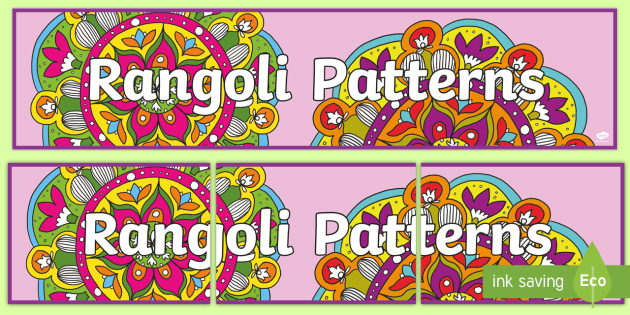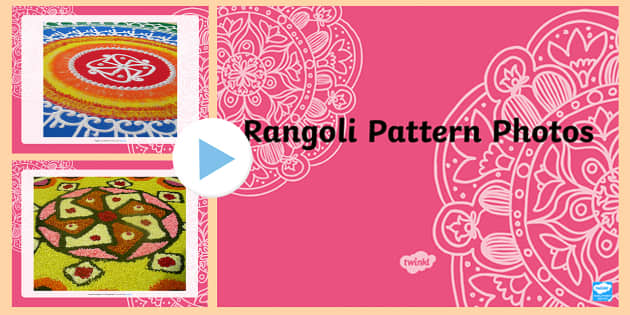


Rangoli is a form of folk art which originated in the Indian subcontinent, where it’s still widely practised today. Rangoli consist of bright, colourful and intricate designs, and they serve a religious and symbolic purpose - to welcome Lakshmi, the Hindu goddess of wealth, as well as any visiting guests. Rangoli can have other meanings, too, including bringing good fortune and keeping evil at bay!
By now, we’ve got a working understanding of what rangoli are, but where did they come from?
There are lots of different stories throughout India which explain where this stunning form of art originated from. One story goes back to the Sanskrit epic Ramayana and tells how the people of Ayodhya, an ancient city in India, made rangoli patterns to welcome Rama on his return from the forest he was banished to for fourteen years. Rama is a deity of Hinduism and his story is told at Diwali.
Rangoli patterns are often made during Diwali - the Hindu festival of lights. However, you can also see them at events like weddings, special occasions, religious celebrations and other Hindu festivals like Pongal, Tihar and Onam. At these times, families will make their own rangoli patterns to display.
Besides big events like weddings or Diwali, rangoli are sometimes created year-round. Many mothers in India create rangoli every morning and teach their daughters how to make them in order to keep the tradition going. Even outside of India, many people belonging to the Indian diaspora also create stunning rangoli to connect with their culture.
Besides looking beautiful and having deep symbolic value, rangoli can also serve a practical function - to keep the entrance of the home clean and prevent insects from going inside. Materials like limestone or cereal powders can be great for either repelling or for attracting a variety of small creatures.

Rangoli patterns are always made on the floor or on a board that can be carried to the spot where it's going to be displayed. They are often placed outside a house by the doorstep, and can be created using a variety of materials such as limestone, quartz powder, cereal powders, rocks and even flowers.
First, the outline is drawn and then the pattern in filled in with colour. Rangoli patterns are very colourful and usually inexpensive - this means that everyone can make them using what they have. Before synthetic pigments were available, people would have made dyes from natural things like tree bark and other plants for their rangoli patterns. Rangoli can even be made from edible materials like lentils and rice powder to feed birds and insects!
Rangoli patterns are often designed to be symmetrical, but they can sometimes be much more elaborate and complex. They combine straight lines, curved lines and images like flowers and other things from nature. The symmetry of the designs is a symbol of prosperity, growth, and luck. Rangoli patterns can be small or large. In parts of India, rangoli competitions are held, at which teams of people work together to produce larger designs to be judged and for the public to enjoy.
Yes! All throughout India and elsewhere, different communities all have their own ways of creating rangoli. The shape, design, colours and symmetry can vary quite a bit across different Indian states. In fact, the art form is known by a variety of different names, such as muggu in the state of Andhra Pradesh and aripan in Bihar.
In Bengal and in parts of Bangladesh, people perform a similar type of folk art called alpona. Artists will first prepare a smooth surface using cow dung, and then draw intricate patterns and motifs using a white paste or powder. The results are often beautiful and highly symbolic, and alpona can sometimes stretch across entire streets!
Lots of people in Southern India practise a variation of rangoli art called kolam. In stark contrast to other forms of rangoli, kolam puts a strong emphasis on precision and symmetry rather than lots of bright colours. As you can imagine, it takes a bit of skill, and true masters of this art form can draw freehand or without even needing to lift their hand when drawing.
Now that we’ve taken a look at some of these different types, let’s move on and explore the relationship between Diwali and rangoli art!
Diwali and rangoli are inextricably linked to one another - just like how holly, mistletoe and Christmas trees symbolise Christmas, rangoli are an essential part of the Diwali celebrations!
The holiday of Diwali is commonly associated with the goddess Lakshmi, and so it’s common for people to create colourful rangoli patterns to welcome her into their homes. Typically, women and girls will create rangoli, but men and boys may sometimes take part in this tradition as well.

The triumph of good over evil and light over darkness is an important motif of Diwali, and rangoli floor patterns are created at the entrances to homes, offices and other places to ward off evil. During Diwali, rangoli are often accompanied by lots of small oil lamps called diya, which emit a warm glow and light up the nights during the Diwali celebrations.
If you are teaching about Diwali, you might like children to complete some rangoli patterns of their own as part of their learning. Our teaching materials and learning resources are made by teachers to help you combine teaching and fun in your lessons. Have a look at some of these recommendations for ideas on teaching about Diwali and rangoli patterns:


This video should give you some more ideas for using resources like our rangoli colouring sheets to extend your Maths teaching.
 Home
Home  Membership
Membership  Customer Support
Customer Support  Create
Create  Blog
Blog 



















